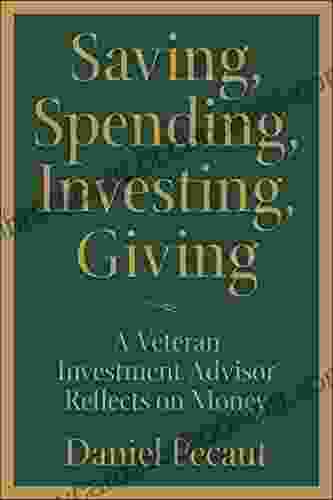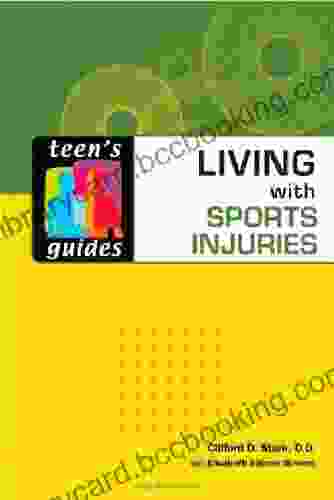Living With Sports Injuries: The Ultimate Teen Guide to Recovery and Prevention

If you're a teen athlete, chances are you've experienced a sports injury at some point. Whether it's a sprained ankle, a pulled muscle, or a concussion, injuries can be frustrating, painful, and even debilitating. But they don't have to be. With the right information and support, you can recover from your injury quickly and safely, and get back to ng what you love.
5 out of 5
| Language | : | English |
| File size | : | 1890 KB |
| Text-to-Speech | : | Enabled |
| Word Wise | : | Enabled |
| Print length | : | 202 pages |
| Screen Reader | : | Supported |
This guide will provide you with everything you need to know about sports injuries, from prevention to treatment and recovery. We'll cover everything from the most common types of injuries to the latest treatment options, and we'll provide you with tips and advice from experts in the field.
Chapter 1: Understanding Sports Injuries
The first step to recovering from a sports injury is to understand what it is. Sports injuries are caused by a variety of factors, including:
* Trauma: This is the most common cause of sports injuries. Trauma can occur when you fall, get hit by another player, or collide with an object. * Overuse: This type of injury occurs when you repeat the same motion over and over again, which can put stress on your muscles, tendons, and ligaments. * Poor conditioning: If you're not in good shape, you're more likely to get injured. This is because your muscles, tendons, and ligaments are not as strong as they could be, which makes them more susceptible to injury.
There are a number of different types of sports injuries, including:
* Sprains: Sprains are injuries to ligaments, which are the tough bands of tissue that connect bones together. Sprains can range from mild to severe, depending on the severity of the ligament damage. * Strains: Strains are injuries to muscles or tendons, which are the tissues that connect muscles to bones. Strains can also range from mild to severe, depending on the severity of the muscle or tendon damage. * Concussions: Concussions are brain injuries that are caused by a blow to the head. Concussions can range from mild to severe, and can cause a variety of symptoms, including headache, nausea, vomiting, dizziness, and confusion. * Fractures: Fractures are breaks in bones. Fractures can range from minor to severe, and can require surgery to repair.
Chapter 2: Preventing Sports Injuries
The best way to deal with a sports injury is to prevent it from happening in the first place. There are a number of things you can do to reduce your risk of getting injured, including:
* Warm up before you play: Warming up your muscles before you play will help to prepare them for activity and reduce your risk of injury. * Cool down after you play: Cooling down your muscles after you play will help to reduce muscle soreness and stiffness, and can also help to prevent injuries. * Use proper technique: Using proper technique when you play will help to reduce your risk of injury. For example, if you're playing basketball, make sure you're landing on your feet instead of your heels. * Get enough rest: Getting enough rest will help your body to recover from workouts and practices, and can also help to prevent injuries. * Eat a healthy diet: Eating a healthy diet will help to give your body the nutrients it needs to stay strong and healthy, and can also help to prevent injuries. * Get regular medical checkups: Getting regular medical checkups can help you to identify and address any potential health problems that could increase your risk of injury.
Chapter 3: Treating Sports Injuries
If you do get injured, it's important to seek treatment as soon as possible. Treatment for sports injuries can vary depending on the type of injury, but may include:
* Rest: Rest is the most important thing you can do to treat a sports injury. Rest will give your body time to heal, and will help to reduce pain and swelling. * Ice: Ice can help to reduce pain and swelling. Apply ice to the injured area for 15-20 minutes at a time, several times a day. * Compression: Compression can help to reduce swelling. Apply a compression bandage to the injured area, but be sure not to wrap it too tightly. * Elevation: Elevating the injured area can help to reduce swelling. Prop the injured area up on pillows while you're resting. * Medication: Over-the-counter pain medication can help to relieve pain and inflammation. Ibuprofen and naproxen are two common pain medications that are used to treat sports injuries. * Surgery: Surgery may be necessary to repair a severe sports injury. Surgery is typically performed by an orthopedic surgeon.
Chapter 4: Recovering from Sports Injuries
Recovery from a sports injury can take time, but it's important to be patient and to follow your doctor's Free Downloads. Recovery may include:
* Physical therapy: Physical therapy can help you to regain range of motion, strength, and function in the injured area. Physical therapy typically involves exercises and stretches that are designed to strengthen the injured area and improve its mobility. * Rehabilitation: Rehabilitation is a process that helps you to return to your previous level of activity after an injury. Rehabilitation may include physical therapy, as well as other activities such as cycling, swimming, and running. * Rest: Rest is important for both the physical and mental recovery process. Make sure you get plenty of rest, and avoid ng activities that could reinjure your injury. * Nutrition: Eating a healthy diet can help to speed up the healing process. Make sure you're eating plenty of fruits, vegetables, and whole grains. * Positive attitude: Having a positive attitude can help you to stay motivated during the recovery process. Believe in yourself and your ability to recover, and don't give up.
Sports injuries are a common part of life for teen athletes. But with the right information and support, you can recover from your injury quickly and safely, and get back to ng what you love. This guide has provided you with everything you need to know about sports injuries, from prevention to treatment and recovery. We hope you've found this guide helpful, and we wish you all the best in your recovery.
5 out of 5
| Language | : | English |
| File size | : | 1890 KB |
| Text-to-Speech | : | Enabled |
| Word Wise | : | Enabled |
| Print length | : | 202 pages |
| Screen Reader | : | Supported |
Do you want to contribute by writing guest posts on this blog?
Please contact us and send us a resume of previous articles that you have written.
 Book
Book Novel
Novel Page
Page Chapter
Chapter Text
Text Story
Story Genre
Genre Reader
Reader Library
Library Paperback
Paperback E-book
E-book Magazine
Magazine Newspaper
Newspaper Paragraph
Paragraph Sentence
Sentence Bookmark
Bookmark Shelf
Shelf Glossary
Glossary Bibliography
Bibliography Foreword
Foreword Preface
Preface Synopsis
Synopsis Annotation
Annotation Footnote
Footnote Manuscript
Manuscript Scroll
Scroll Codex
Codex Tome
Tome Bestseller
Bestseller Classics
Classics Library card
Library card Narrative
Narrative Biography
Biography Autobiography
Autobiography Memoir
Memoir Reference
Reference Encyclopedia
Encyclopedia Claiborne Young
Claiborne Young D Ward Cornell
D Ward Cornell Curt Warner
Curt Warner Cynthia Moss
Cynthia Moss Dan Rottenberg
Dan Rottenberg Crystal Chigbu
Crystal Chigbu Danelle Murray
Danelle Murray Dan Price
Dan Price Clea Translations
Clea Translations D B Eshleman
D B Eshleman Dana Goldstein
Dana Goldstein Dan Murphy
Dan Murphy D S Malik
D S Malik Colleen Houck
Colleen Houck Dana Angelo White Ms Rd At
Dana Angelo White Ms Rd At Dan Dipiro
Dan Dipiro Dan Jenkins
Dan Jenkins Courtney Friel
Courtney Friel Cliff Lerner
Cliff Lerner Colin Brake
Colin Brake
Light bulbAdvertise smarter! Our strategic ad space ensures maximum exposure. Reserve your spot today!

 Corey HayesCovid Summer: A Literary Masterpiece that Explores the Profound Truths of a...
Corey HayesCovid Summer: A Literary Masterpiece that Explores the Profound Truths of a...
 Charlie ScottCultural History of Touch Studies: Unraveling the Sensory Tapestry of Human...
Charlie ScottCultural History of Touch Studies: Unraveling the Sensory Tapestry of Human...
 Vladimir NabokovMaster Essential English Vocabulary: A Comprehensive Guide to Core Vocabulary...
Vladimir NabokovMaster Essential English Vocabulary: A Comprehensive Guide to Core Vocabulary... Chris ColemanFollow ·7.3k
Chris ColemanFollow ·7.3k Matt ReedFollow ·5.5k
Matt ReedFollow ·5.5k Ernest J. GainesFollow ·11.2k
Ernest J. GainesFollow ·11.2k Arthur C. ClarkeFollow ·6.3k
Arthur C. ClarkeFollow ·6.3k Drew BellFollow ·9.9k
Drew BellFollow ·9.9k Ivan TurnerFollow ·14.8k
Ivan TurnerFollow ·14.8k Isaiah PriceFollow ·14.4k
Isaiah PriceFollow ·14.4k Randy HayesFollow ·18.4k
Randy HayesFollow ·18.4k

 Donald Ward
Donald WardVeteran Investment Advisor Reflects On Money
Unlocking Financial Wisdom...

 Fernando Pessoa
Fernando PessoaUnlock the Secrets of Value Investing with "University of...
In the realm of investing, there stands an...

 Jorge Luis Borges
Jorge Luis BorgesMaster Spanish Vocabulary with Ap Spanish Flashcards...
Are you eager to expand your Spanish...

 Roger Turner
Roger TurnerPlay Like a Pro: The Ultimate Guide to Becoming a Master...
Are you ready to...
5 out of 5
| Language | : | English |
| File size | : | 1890 KB |
| Text-to-Speech | : | Enabled |
| Word Wise | : | Enabled |
| Print length | : | 202 pages |
| Screen Reader | : | Supported |










